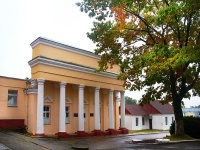- Home
- →
- Attractions
- →
- Building of the former gymnasium
Building of the former gymnasium
The former building of the Svisloch Gymnasium is one of the key historical landmarks in the Grodno region, associated with prominent figures of Belarusian history. Founded in the early 19th century, this educational institution became a center of enlightenment and revolutionary ideas. Today, only the right wing of the once magnificent building has been preserved, but its walls still hold the memory of many famous graduates.
History of Establishment
The Svisloch Gymnasium was founded in 1804 as the Grodno Governorate Academic Gymnasium. It was officially opened in 1805 on the initiative of the Vilnius Educational District, managed by Vilnius University. The institution was intended to educate young people from the western counties of Belarus and Lithuania. Over time, it produced renowned graduates such as Kastus Kalinouski, Romuald Traugutt, Józef Ignacy Kraszewski, Napoleon Orda, and others. In the 1830s and 1860s, the gymnasium became a hub for revolutionary movements, leading to its gradual closure and transformation into a progymnasium and later into a teacher’s seminary. Today, the preserved right wing of the building houses the children's department of the Svisloch Central District Hospital.
Architecture
Originally, the gymnasium building was a classical architectural ensemble with a symmetrical composition, a central building, and two side wings. The interior spaces were characterized by spacious classrooms with richly decorated interiors. However, during World War II, the main building was severely damaged and later completely dismantled. In the post-war period, a district hospital was built in its place, and the left wing was demolished. Today, only the right wing remains, now used for medical purposes.
Excursions
Excursions in Belarus, including visits to Svisloch, offer an opportunity to explore the history and cultural heritage of this region. The former gymnasium building is one of the intriguing sites to visit during a tour from Minsk or other cities. Tourists can learn about the role of this institution in the national liberation movement, its famous alumni, and its influence on Belarusian culture. Additionally, visitors can explore memorial sites related to Kastus Kalinouski.

